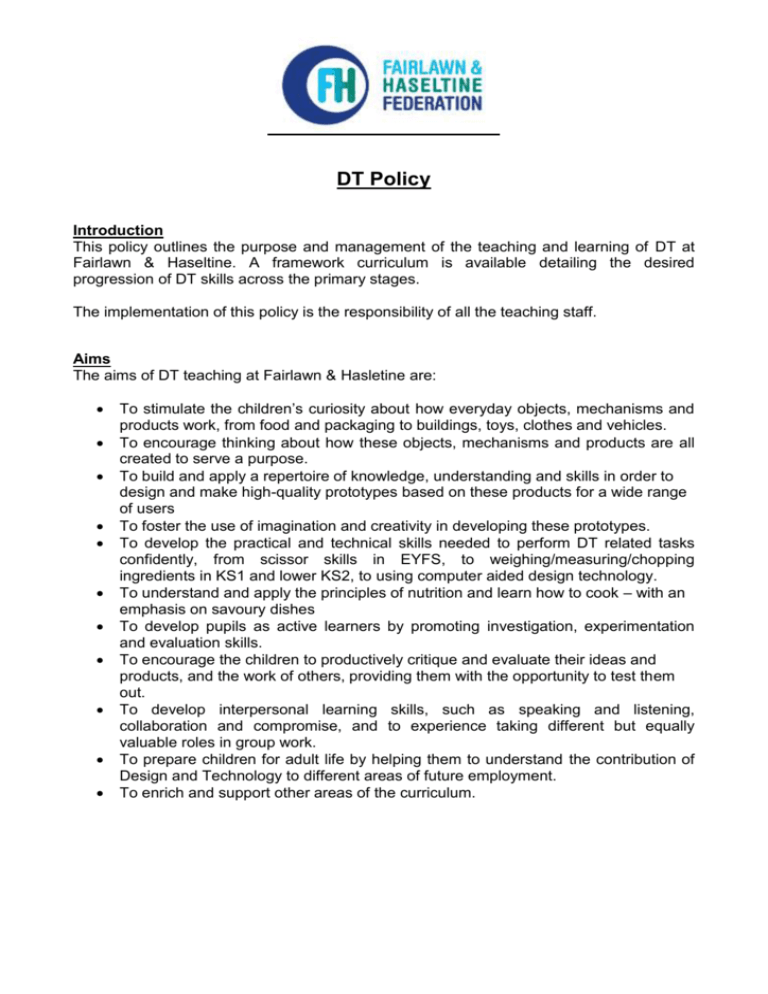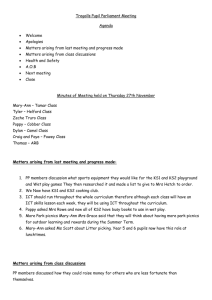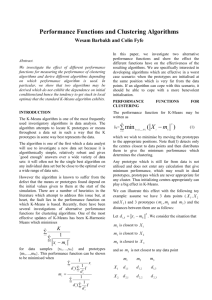View our DT Policy here - Fairlawn Primary School
advertisement

DT Policy Introduction This policy outlines the purpose and management of the teaching and learning of DT at Fairlawn & Haseltine. A framework curriculum is available detailing the desired progression of DT skills across the primary stages. The implementation of this policy is the responsibility of all the teaching staff. Aims The aims of DT teaching at Fairlawn & Hasletine are: To stimulate the children’s curiosity about how everyday objects, mechanisms and products work, from food and packaging to buildings, toys, clothes and vehicles. To encourage thinking about how these objects, mechanisms and products are all created to serve a purpose. To build and apply a repertoire of knowledge, understanding and skills in order to design and make high-quality prototypes based on these products for a wide range of users To foster the use of imagination and creativity in developing these prototypes. To develop the practical and technical skills needed to perform DT related tasks confidently, from scissor skills in EYFS, to weighing/measuring/chopping ingredients in KS1 and lower KS2, to using computer aided design technology. To understand and apply the principles of nutrition and learn how to cook – with an emphasis on savoury dishes To develop pupils as active learners by promoting investigation, experimentation and evaluation skills. To encourage the children to productively critique and evaluate their ideas and products, and the work of others, providing them with the opportunity to test them out. To develop interpersonal learning skills, such as speaking and listening, collaboration and compromise, and to experience taking different but equally valuable roles in group work. To prepare children for adult life by helping them to understand the contribution of Design and Technology to different areas of future employment. To enrich and support other areas of the curriculum. Objectives We will achieve these aims by the following objectives: Children will study how objects, mechanisms and products work, using real-life and hands-on examples, making comparisons between and within them. Children will be given opportunity to use quality tools and materials, appropriate to their age and the desired project outcome, enabling them to produce attractive and good quality end-products DT is a practical, physical subject: children will all be given hands-on opportunities to weigh, measure, mix, chop, saw, glue, cut, sew, print. Children will be encouraged to evaluate their own and their peers’ DT learning, and to form judgments about how they can improve their own work; at Fairlawn & Haseltine, no DT learning is complete until this has taken place. Children will have access to a range of sources for their DT research such as prototypes, materials, photographs, written matter, ICT based sources, TV / video/DVD extracts. Children will learn in a variety of contexts - individually, in groups, as a whole class Children will learn to present their knowledge and understanding in a variety of ways such as demonstrations, instructions, discussions, and written and oral evaluations. As skills, understanding and confidence develop, the children will begin to make significant contribution to the design brief of the DT projects. Teaching and learning We place an emphasis on examining real life technologies/mechanisms/products. In each key stage, we will provide the children with prototypes/examples to explore, try-on, handle, take apart and reconstruct. The children are encourages to experiment and ask searching questions: ‘how does this work? How can I make it work better? We recognise the value and importance of DT being integrated with other subjects in the curriculum, and that this can be a powerful way to stimulate interest and consolidate learning. Through our medium and long term planning, we ensure that all relevant and effective cross-curricular links are made, especially with science and history. Equal opportunities We plan our classroom activities to challenge and involve all pupils appropriately, according to age and capability, ethnic diversity, gender and language background. We use materials for teaching, which avoid stereotyping and bias towards race, gender and role of disability. We deal with such issues clearly and sensitively when they arise. We recognise the fact that in all classes there are children of widely different abilities in DT and we seek to provide suitable learning opportunities for all children by matching the challenge of the task to the ability of the child. We achieve this by: Setting common tasks which are open-ended and can have a variety of responses Setting tasks of increasing difficulty Organising children by ability when appropriate in the classroom and setting different tasks for each ability group Providing resources of different complexity depending on the ability of the child Using teaching assistants to support children’s learning individually or in groups DT curriculum planning We have a framework curriculum, available for all teachers to consult on the staff shared server, which details the desired skills progression – practical, social and intellectual – in terms of DT learning across the key stages. In addition, as a school, we have a detailed, project-based curriculum, running across the whole school, which is updated and adapted for the start of each academic year. This is broken down by the curriculum leader into half-termly over-views for each year-group. In common with other subject leaders, the DT leader has suggested projects/ways to link DT to other areas of the curriculum in these half-termly overviews. All of these documents are available for class teachers to consult on the staff shared server. The class teacher writes the lesson plans for each DT lesson (short-term plans). These plans list the specific learning objectives and expected outcomes of each session. The class teacher keeps these individual plans, although s/he and the DT leader discuss them on an informal basis. DT and ICT We use ICT to support and enhance the teaching and learning in DT. Children use ICT to enhance their research skills using the Internet. They have the opportunity to use the digital camera/Ipads to record photographic images and movie clips of their DT projects, using these to document their learning-in-progress, and present their learning to others. At Haseltine, children in upper Key Stage 2 have the opportunity to use CAD software to design products for printing on the 3D printer. Assessment for learning Children demonstrate their ability in DT in a variety of different ways. Younger children might, for example, show accuracy in using scissors/drawing against a ruler, while older children may use craft knives safely and with precision, or cook a meal on a fire trench as a WW1 soldier would have; at the upper end of KS2, they may use CAD software to design a cookie cutter. Teachers will assess children’s learning by making informal judgments during lessons and comments on the year-group-appropriate skills shown, with reference to the DT framework curriculum. We regard it as essential that all children evaluate their own and their peers’ DT learning, forming judgments about how they can improve their own work – the teacher should not regard the DT learning complete until this has taken place. On completion, the teacher assesses and uses this information to plan future learning. Written or verbal feedback is given to the child to help guide his or her progress. This information is passed on to the next teacher at the end of the year. The subject leader is building a portfolio (photographic and/or prototype) of samples of the children’s work, which will show the expected level of achievement in DT in each year of the school. Resources DT is well resourced in our schools, enabling class teachers to deliver all the units. In addition, there is a DT cupboard with consumables such as lolly stick, balsa wood, wheels, cams, dowel, glue guns etc. At Haseltine, in each Key Stage corridor there is a DT trolley containing age-appropriate tools and equipment, which can be wheeled into the classroom as needed. There is also have a 3D printer on site, and the KS2 laptops have design software installed. Roles and responsibilities Each class teacher has the responsibility for the teaching of DT and needs to ensure that they read the DT curriculum, and that they have or develop the necessary skills to teach the termly units. Where 3D printer projects are chosen, the class teachers will have support from the DT leader and/or ICT leader/Art leader, all of whom have training/experience in using the software and printer. The subject leader is responsible for: Taking the lead in the development, evaluation and amendment of schemes of work as and when necessary. Monitoring the standard of the children’s learning and the quality of teaching in DT. Supporting colleagues in their teaching Being informed about current developments in the subject. Providing a strategic lead and direction for DT in school. Resourcing the curriculum by renewing, updating and complementing resources where necessary. Managing a delegated budget. Keeping a leveled portfolio of children’s work. Review: September 2016 Signed by chair of governors: ____________________________ Date: ___________________________________








